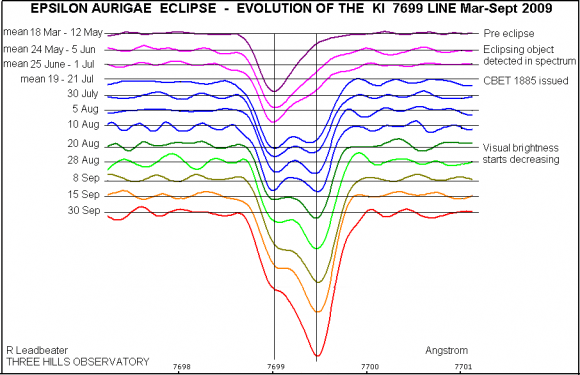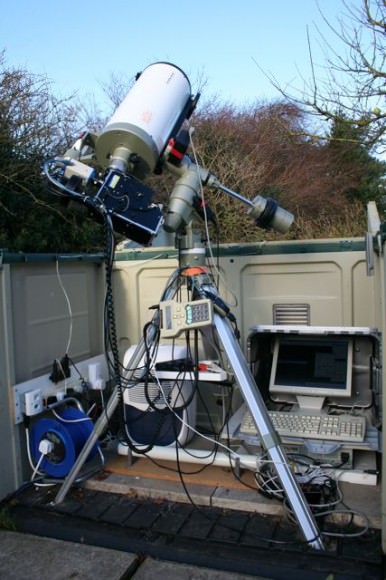[/caption]
Amateur astronomers are a unique species worthy of their own reality TV show. Their craftsmanship, resourcefulness, dedication, and passion is simply amazing. Many professional astronomers rely heavily on amateurs for quick spot checks, discovery followups, collaboration on research projects, the diverse locations of their telescopes and their ability/willingness to put in long hours of observation. So what is spectroscopy, and what do the amateur astronomers get up to?
Absorption spectroscopy is the study of the color and light spectrum of stars and galaxies. We all love our Hubble photos and pretty astro-photographs, however most of the real research and science comes from observing the light spectrum.
Robin Leadbeater’s LHIRESIII Spectrograph
Astronomers look at emission lines and absorption lines in the spectra to determine the make up of stars, nebulas and galaxies. Dopler effects, orbital behavior, elements of stars, even atmospheres can be determined by observing these absorption and emission lines. Scientists believe that a carbon dioxide absorption spectrum line signature in the spectrum of a star with a transiting exo-planet could eventually be the most exciting discovery – a possible indicator of extra-terrestrial life.
Why are amateurs interested?
I asked Ken Harrison the moderator of the Yahoo group – Astronomical Spectroscopy, why amateurs would be interested in absorption spectra?
“I see it as the “last frontier” for amateur astronomers. When you’ve taken the 100th image of the Orion nebulae – what do you do next?? It’s challenging, interesting and can give some scientific value to your work. Amateurs have successfully recorded the spectra of nova before the professionals and complimented other variable star work with observations of the changing spectral emissions of stars showing their Doppler shifts and atmospheric changes.”
Ken specializes in the spectra of Wolf-Rayet stars and is currently writing a book on amateur spectroscopy. Ken has been building his own spectrographs since 1992 and has used a variety of devices ranging from a simple star analyzer on a digital SLR camera to a sophisticated guided spectrograph.
A spectrograph allows light to pass through a narrow slit where it is then split into it’s spectra by passing through some sort of diffraction grating, before being captured on a CCD. The plate scale of the CCD then comes into play as angstroms per pixel instead of the usual (astrometric measure) arc/secs per pixel.
Rob Kaufman recently captured a Nova outburst Nova Scuti 2009 (V496 SCT) between the trees and clouds from his back yard.

Italian amateur Fulvio Mete has achieved a spectrographic separation of tight binary Beta Aurigea. The double Ha absorption line is easily identifiable in his image taken with a 14inch Celestron. Some of the world’s best telescopes are unable to separate Beta Aurigea optically, so being able to do a spectrographic separation with a back yard telescope is a significant achievement.

Perhaps there is no finer example of the quality of the spectroscopy done by amateurs than the current citizen science project on the eclipse of binary Epsilon Aurigae. Robin Leadbeater from Three Hills Observatory, a team member/contributor to the Citizen Sky project and avid amateur astronomer, has documented the changing spectra of Epsilon Aurigae, in particular monitoring the changing KI (neutral potassium) 7699 absorption line during the early stages of the ingress.

The eclipse happens every 27 years and this eclipse will be the first to be fully documented with advanced spectroscopy – clearly alot of that will be performed by skillful amateurs.
So what equipment do I need?
Ken Harrison comments that the equipment required is not necessarily expensive and it is a lot of fun.
“Luckily with the filter gratings available at reasonable prices (Star Analyser, Rainbow Optics etc) interested amateurs can start using their current equipment with minimal cost and outlay. Freeware programs like IRIS (C Buil) and VSpec (V Desnoux) allow the detailed analysis of spectra to be done without all the mathematics or detailed physics. As experience grows so do the questions. What do those absorption features mean? Why does this spectrum look completely different from that spectrum? How can I get benn resolution? Yes, it has its learning curve like any new adventure, but there are many others who have trodden the road before and only too willing to assist – To boldly go where few amateurs have gone before – Spectroscopy!!!”
Dale Mais another dedicated amateur from Orange Grove, San Diego County has an excellent paper on qualitative and quantitative analysis that can be achieved by amateur astronomers.
The contribution of amateurs across all forms of astronomy is significant, and spectroscopy is no exception. If you want more information join one of the Yahoo groups or major amateur astronomy forums as they all have discussion groups with experienced people who are keen to help you get started.
Special thanks to Ken Harrison, Robin Leadbeater, Rob Kaufman, Fulvio Mete and Dale Mais for your photos and insight!



Man, Leadbeater’s setup is just damn sexy.
At the eighth paragraph, in the first line:
That should be its, possessive form of the pronounit, not “it’s”.
Damn stupid HTML tags! I’ll try that again…
That should be its, possessive form of the pronoun it, not “it’s”.
P.S. We need a bloody preview/edit facility here!
Thanks Peter, it is a very interesting and informative article.
The article says: “Scientists believe that a carbon dioxide absorption line signature in the spectrum of a star with a transiting exo-planet could eventually be the most exciting discovery – a possible indicator of extra-terrestrial life.”
But, don’t we already know that there’s CO2 on Mars, a mere 35 million miles away at times. And Methane. And Water. And temperatures that reach the 60’s or 70’s, even on the surface. And meteors from there that suggest previous life. And Why aren’t we looking for life there now?
Add science entertainment sites that aren’t willing to review a book pondering the answer. Quite an interesting little puzzle.